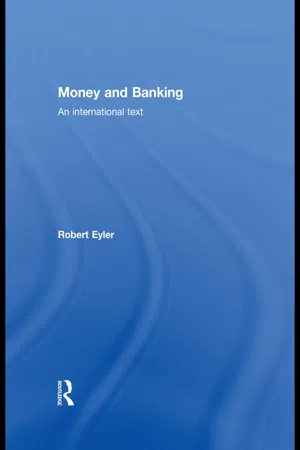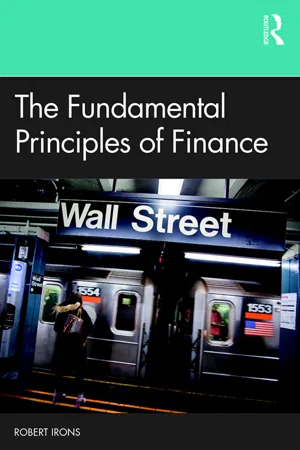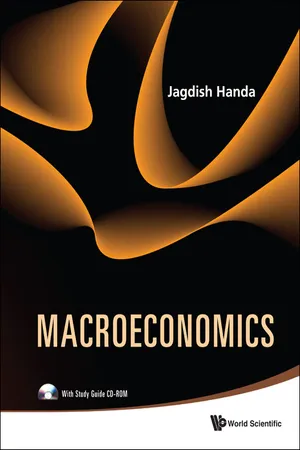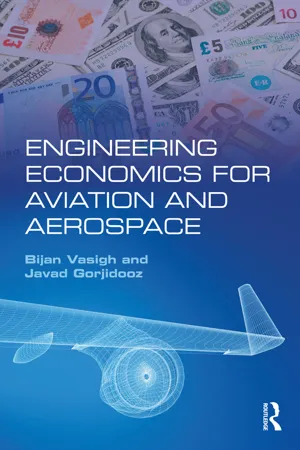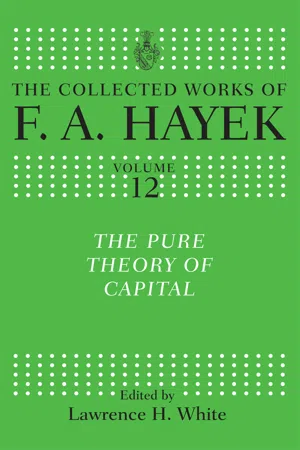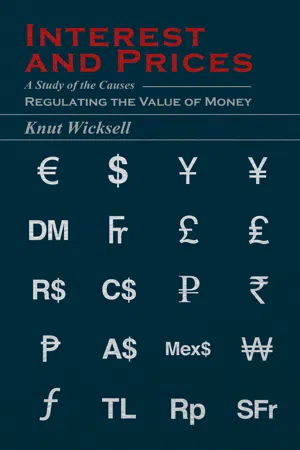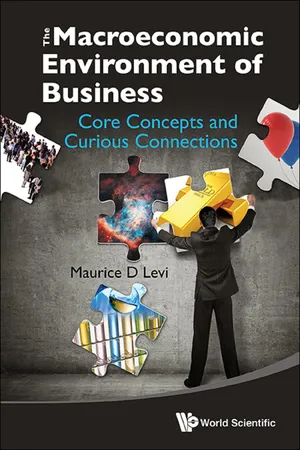Economics
Nominal vs Real Interest Rates
Nominal interest rates refer to the stated interest rate on a loan or investment, while real interest rates take into account the effects of inflation. Real interest rates provide a more accurate measure of the true cost of borrowing or the real return on an investment, as they adjust for changes in purchasing power.
Written by Perlego with AI-assistance
Related key terms
7 Key excerpts on "Nominal vs Real Interest Rates"
- eBook - ePub
Money and Banking
An International Text
- Robert Eyler(Author)
- 2009(Publication Date)
- Routledge(Publisher)
Interest rates come in many forms, all with the same basic set-up. An interest rate includes measures of risk, both general and very specific. When you borrow money, the rate at which you borrow is the nominal rate. This rate is the stated interest cost or return of a financial investment. There is also a real rate, but what separates the two? The difference between nominal and real variables in economics has to do initially with inflation, or purchasing power erosion, and other risks. In its most basic form, a nominal interest rate has the following equation:R = r + P(2.1) where R is a nominal rate, r is the associated real rate and P is the expected inflation rate. Equation 2.1 assumes the only risk to be inflation. The best way to think of the real rate of interest is what the lender wants to receive as revenue, less the calculated risks. The nominal rate is the sum of the real rate and the “expected” inflation rate, which is a calculated guess and not the actual inflation rate. When a lender provides a loan, the lender must make conjectures concerning what the risk of future inflation may be. Unless the interest rate is allowed to adjust with new inflation information, the lender bears that risk directly; when inflation rises without the nominal rate changing, the real value of her loan gets smaller. Both the borrower and lender make decisions based on their individual assessment of the real rate of interest. Even though the borrower writes a check every month to the credit card company based on a nominal rate, the lender is seeking protection of the real rate as the driving force behind providing credit. If all the expected risks play themselves out as predicted, the borrower and lender pay and receive the real rate respectively.We will discuss later the difference between fixed and variable rates of interest, but keep in mind that few assets, real or financial, can circumvent the risk of inflation. Inflation is also a representation of time in financial markets, specifically eroding nominal income and wealth.Defining interest rates
The cost of borrowing
This is the classic role we think of interest rates playing in finance, an explicit cost of consuming beyond one’s income or wealth by choice. As a corollary, it is also the opportunity cost of consuming, regardless of the entity being a net consumer or not. A net consumer is a household that both consumes and saves, but consumes more than its income in net. If one consumes anything, there is lost interest revenue from saving the resources otherwise; however, financial leverage may be a decision because the cost of debt is less than the return to savings. Households are willing to bear this cost, however, at some level because of necessity and because of satisfaction or utility otherwise, an issue discussed in more detail in Chapter 9 - eBook - ePub
- Robert Irons(Author)
- 2019(Publication Date)
- Routledge(Publisher)
When discussing interest rates, we must specify if we are discussing real rates or nominal rates. Real rates of interest do not contain any consideration for inflation (the inflation is stripped out of them), while nominal interest rates include a premium for expectations of inflation over the life of the debt instrument. Investors concern themselves with nominal interest rates, as they expect to be compensated for inflation. Researchers tend to focus on real interest rates so that they can directly compare interest rates across different periods of time without dealing with the effects of inflation. Unless stated otherwise, this textbook will focus on nominal interest rates. We will, however, look at real rates of interest, as well as inflation. Real interest rates will be indicated as real, whereas nominal interest rates might not be designated so.Inflation is the erosion of purchasing power; a loaf of bread may be $1.50 this year but rise to $1.65 next year. If this expectation of rising costs is not built into the interest rate earned by lenders, investors will lose purchasing power over time. For example, the change in the price of bread referred to above is a 10% increase. Assuming that prices in general are rising by 10%, if lenders are only earning 7% interest on their money, they are losing purchasing power of 3%. Since inflation is an ongoing force in the economy, prices are expected to rise on an ongoing basis. Therefore, investors will insist on receiving a premium that accounts for the future expectations of inflation over the life of the investment. A 1-year bond will include a premium for the inflation expected for next year, while a 5-year bond will include a premium to cover the expected inflation over the next five years.The Determinants of Interest Rates
In order to be willing to postpone consumption of their income and lend their money out to others, investors must be compensated for the time during which their money is unavailable. This is the basis for the time value of money, as discussed in Chapter 2 . The minimum rate of interest that lenders expect to earn is known as the nominal risk-free rate of interest, or the risk-free rate. The nominal risk-free rate (r) is comprised of the real risk-free rate (r*) and an inflation premium (IP)—that is, rRFRF - eBook - ePub
Macroeconomics
(With Study Guide CD-ROM)
- Jagdish Handa(Author)
- 2010(Publication Date)
- WSPC(Publisher)
actual real rate of return is specified by:where ra is the actual real rate of interest. The actual/realized real rate of return on loans (ra ) differs from the expected one (re ) if actual inflation differs from the expected one, which does happen frequently.26 Note that if the rate of inflation is greater than the market interest rate, the actual (ex-post) real return would be negative.Fact Sheet 2.4 : Nominal and Real Interest Rates in the USA, 1982-2008The Fisher equation implies that the real interest rate is the difference between the nominal interest rate and the expected inflation rate. In simple applications, the expected inflation rate is approximated by the actual one. The following graph illustrates the relationship over time between the nominal interest rate on Treasury bills and the actual inflation rate using USA data. Their difference yields the actual real interest rate on Treasury bills. Since the real interest rate fluctuates much less than the inflation rate, very high nominal rates are usually due to very high inflation rates, as during the late 1980s. Since 2000, nominal interest rates have been quite low because the inflation rates have been low.The real interest rate fluctuates due to changes in the real sectors of the economy and the monetary policy pursued by the central bank under interest rate targeting. In the USA, since 2000, the central bank has maintained the real interest rate at a fairly low level. - eBook - ePub
- Bijan Vasigh, Javad Gorjidooz(Authors)
- 2016(Publication Date)
- Routledge(Publisher)
4 Nominal and Effective Interest RatesIn regards to the price of commodities, the rise of wages operates as simple interest does, the rise of profit operates like compound interest. Our merchants and masters complain much of the bad effects of high wages in raising the price and lessening the sale of goods. They say nothing concerning the bad effects of high profits. They are silent with regard to the pernicious effects of their own gains. They complain only of those of other people.Adam SmithIn the past two chapters, the interest rates were compounded annually. The majority of investment projects evaluated by professional engineers, and almost all financial institutions, use interest rates that are compounded more frequently than once a year. Common interest compounding time frames are daily, monthly, semi-annually, annually, and continuously compounding. More frequent compounding means that the investors receive a higher return, whereas less frequent compounding results in receiving a lower return. For instance, most credit card companies compound interest daily; that results in effective annual rates that exceed the annual stated interest rates.The focus of this chapter is to enable practitioners and professional engineers to make a distinction between nominal and effective interest rates as applied to the engineering projects and financial activities of aviation and aerospace companies. Nominal and effective interest rates are common in business practices, financial management, and engineering economy. This chapter presents the process of converting nominal interest rates to effective interest rates. - eBook - ePub
- F. A. Hayek, Lawrence H. White, Lawrence H. White(Authors)
- 2019(Publication Date)
- Routledge(Publisher)
It is not a price paid for any particular thing, but a rate of differences between prices which pervades the whole price structure. Insofar as the money rate of interest is concerned, our rate of interest is merely one of the factors which helps to determine it, and is the phenomenon most nearly corresponding to it which we can find in our imaginary moneyless economy. But if it were not for the well-established usage, it would probably have been better to refer to this ‘real’ phenomenon either, as the English classical economists did, as the rate of profit, or by some such term as the German Urzins. 1 Limited Scope of Present Discussion of Money Rate of Interest Although a full discussion of the monetary problems to which the existence of the ‘real’ rate of interest gives rise lies outside the scope of the present book, it would hardly be appropriate to leave our subject without giving a somewhat more definite indication of how the rate of interest we have been discussing and the money rate of interest are related. At this point we can give no more than an outline of the answers to the main problems. A full discussion of the whole complex of problems involved would require another book of about the same size as this one—even supposing that, in the present state of our knowledge, any such systematic and exhaustive treatment of these as yet imperfectly explored problems could be attempted successfully. As has been explained earlier in this volume, its task is to lay the foundations for the treatment of these problems, not to discuss them in any detail. And we shall confine ourselves in this final Part to the task of showing how these theoretical foundations can be used for the elucidation of certain salient points in the discussion of these more complex problems - Knut Wicksell(Author)
- 2011(Publication Date)
- Josephs Press(Publisher)
In the place of attempts to discover whether high prices are accompanied by high or by low rates of interest, it would have been well to elucidate the real meaning of a high or of a low rate of interest. It might then have been seen that it is an essentially relative conception, and that a further datum must be supplied, namely, the level of the natural rate, before it is possible to determine whether any particular rate of interest is to be regarded as high or as low. Such investigations will provide the subject-matter of Chapter 11. We must now consider whether it is possible for credit institutions to maintain their rates of interest at any desired level, or whether they are obliged sooner or later, as a result of the operation on the money market of the forces of supply and demand, to come into line with the natural rate. The latter is the view generally held by economists. In principle they are perfectly right; but they usually omit to provide any clear account of the manner in which the two rates of interest are brought together. The money rate of interest depends in the first instance on the excess or scarcity of money. How then does it come about that it is eventually determined by the excess or scarcity of real capital? “What is interest?” asks F. A. Walker, 1 and proceeds to give the answer. “It is the compensation paid for the use, not of money, but of capital. Money is only one of many forms of capital; and in loans is usually only the agent of effecting a transfer of other forms of capital than itself. If I borrow money, the chances are that I at once, or shortly afterwards, purchase with it articles suitable for my business or my personal necessities. . . . These were what I really borrowed. These are what, in any philosophical view of the subject, I pay interest on; not upon the money. The money was but the means to this end. . . .” This kind of generality is too metaphorical to take us very far- eBook - ePub
The Macroeconomic Environment of Business
Core Concepts and Curious Connections
- Maurice D Levi(Author)
- 2014(Publication Date)
- WSPC(Publisher)
CHAPTER 7 INTEREST RATES“Gentlemen prefer bonds”Andrew MellonKey Concepts: Interest rates and the supply of loanable funds; interest rates and the demand for loanable funds; the equilibrium interest rate; the market versus equilibrium interest rate; monetary policy and interest rates; real growth and interest rates; anticipated inflation and interest rates; real versus nominal interest rates; fiscal deficits, crowding-out and interest rates; international capital flows and interest rates.THE INTEREST IN INTEREST RATESInterest rates have a substantial effect on borrowing and spending decisions of businesses and consumers, and thereby on employment, GDP, and other measures of macroeconomic activity. For example, as we shall see, interest rates influence the willingness of businesses to invest in new plant and equipment, and in turn, the current and future size of the GDP.At the same time that interest rates affect the economy, the economy affects interest rates. This occurs as a result of the effects that national income, inflation and confidence about the future have on the willingness of consumers and businesses to borrow and invest, and hence on the price of borrowing, which is the interest rate. With the direction of flow being in both directions, from interest rates to the economy and from the economy to interest rates, in order to explain interest rates we need a theory that captures this two-way flow of influence. Such a theory is the loanable funds theory. While there are numerous other theories of interest rates, the loanable funds theory embraces many aspects of these other theories, and therefore serves as an ideal window onto the world of interest rates.LOANABLE FUNDS THEORY OF INTERESTAccording to the loanable funds theory, interest rates are determined by the supply of and demand for loanable funds, which can be thought of as monies that can be lent and borrowed. Therefore, in order to explain this theory, we must begin by considering loanable funds supply and demand.
Index pages curate the most relevant extracts from our library of academic textbooks. They’ve been created using an in-house natural language model (NLM), each adding context and meaning to key research topics.
